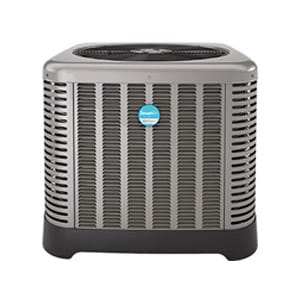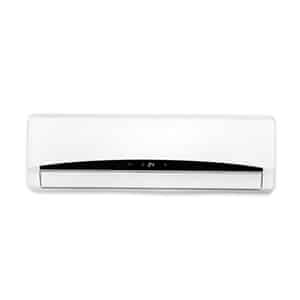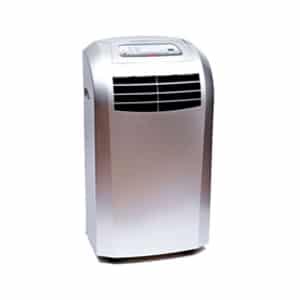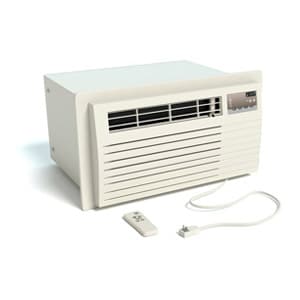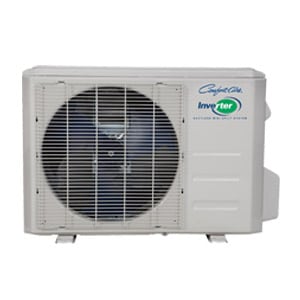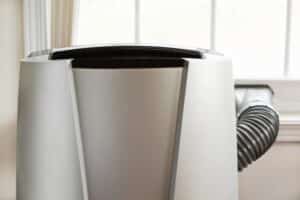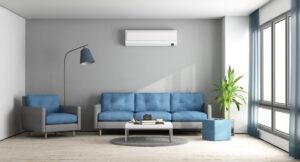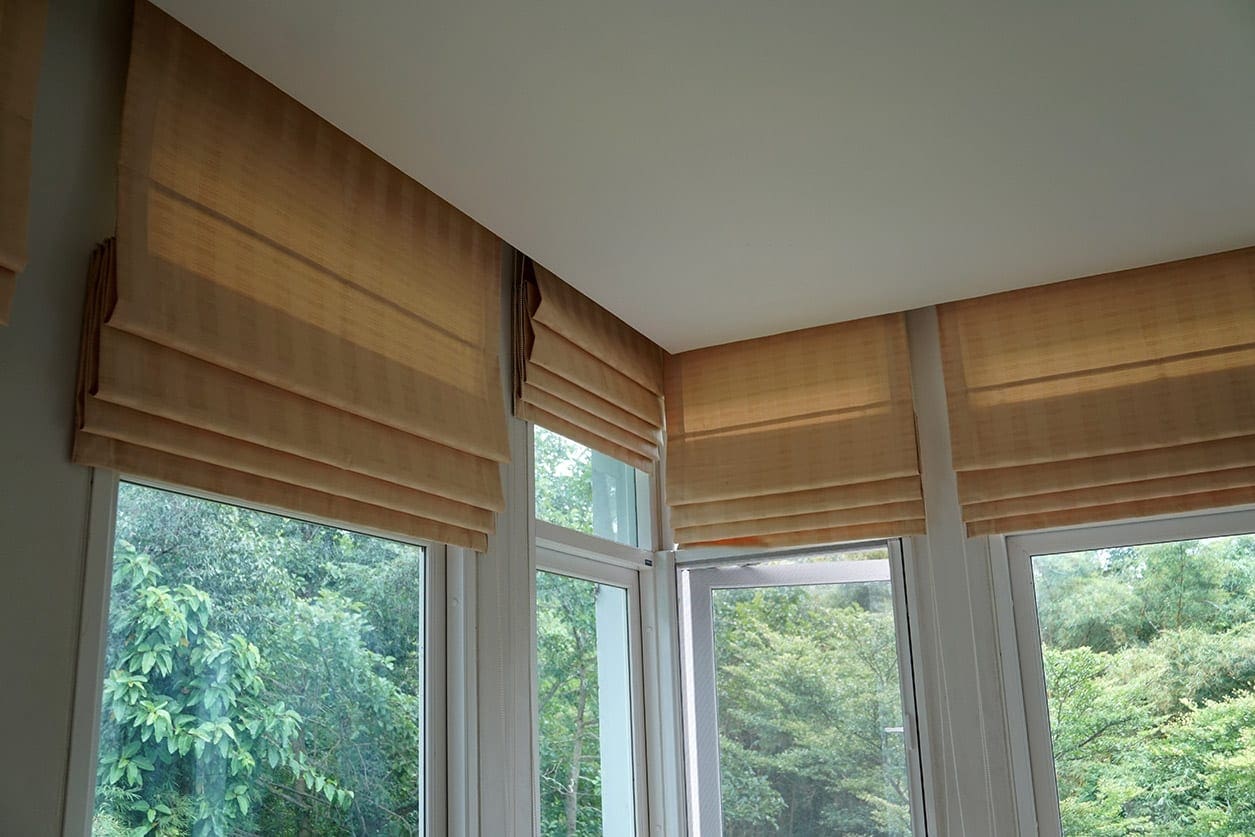Everything you need to know about air conditioners
If you’re like most Canadians, you know that much like our winters, our hot and humid summers can be extreme! When the weather is sweltering hot, you want to make sure you stay cool throughout the day and sleep comfortably at night – and that starts with choosing the right air conditioning system. Home air conditioning systems are more energy efficient than ever before. If you’re looking to upgrade or replace your cooling system, the current AC options available can help keep you cool and save you money for years to come.
But where do you start? Selecting the best air conditioner can seem like a daunting task. This guide is designed to help you navigate through the complex decision making process and provide you with helpful information to help you select the right AC for you and your family.
This guide is intended for information purposes only. A qualified heating and cooling expert will be able to determine the ideal size and solution for your home and climate.
10 things this home AC unit guide will answer

Different Air Conditioner Types
There are many great types of air conditioners available, but choosing the right option comes down to whichever best suits your family’s needs, living space and budget. The most common residential cooling options include:
Select cooling system type:
Central Air Conditioners
What is Central Air Conditioning?
The most common way to cool a home is with a central air conditioning system. The system includes an external condenser unit which sits outside your home and expels heat as well as an evaporator coil, which generally sits above your furnace and cools the air within your home. Finally your furnace or air handle work with your AC using the fan to blow the chilled air through your home’s duct work. As a central air conditioner is integrated with your furnace system, it can take advantage of the furnace filter and any additional air purifying equipment you have added. This helps to clean the air throughout your home.
How Does Central Air Conditioning Work?
A central air conditioner works by using your furnace or air handler fan to draw warm air in through your home’s duct work. As the air is blown across the evaporator coil, which generally sits above your furnace, heat is removed from the air, cooling it down. The removed heat is absorbed into refrigerant running through the coil. This refrigerant is then pumped to the condenser, which is the part of your air conditioner that is outside of your home. The condenser expels this heat into the outside air, cooling the refrigerant, which is then sent back inside the home, to start the process over again.
Central AC Explained In 8 Steps
- As the temperature in your house rises beyond what you set on your thermostat, a signal is automatically sent from your thermostat to the circuit board in your furnace.
- This tells the system that cold air is needed and turns on both the blower motor inside your house and the condenser, which sits outside your home.
- Warm air is then drawn into your ductwork and cooled as it passes over the evaporator coil above your furnace.
- This cooled air is then returned to the home through the return air vents.
- Meanwhile refrigerant in your air conditioner absorbs the heat from the air as it flows through the evaporator coil.
- This heated refrigerant is then pumped to the condenser or outside portion of your air conditioner.
- The condenser blows outside air across a different set of coils, which removes the heat from your home that was absorbed by the refrigerant, before the refrigerant is sent back into the home.
- This process continues until the desired set temperature is met.
What are the benefits of Central Air Conditioning?
Central air conditioners provide cooling to all rooms in the home, not just to select rooms. They also tend to be a more cost effective solution to ductless ACs.
Upgrade your home comfort with our special offers
Check Out Our Offers Today!
Energy Tip
Upgrading your thermostat to a smart thermostat allows you to take control of the temperature in your home and your energy bill.
Central Air Conditioning Benefits When Used With Smart Thermostat
- Control your air conditioner from your mobile device
- It learns your preferences and builds a schedule for you
- Potential savings on your monthly energy bills
- Learn more about thermostats here

Your thermostat plays an important role in making sure the temperature in your home is
optimal.
Choosing the right thermostat can also help to ensure your home is heated and cooled as
efficiently as possible, so, selecting the right thermostat for your home can not only
help you stay comfortable year-round, it can also help you save on your monthly energy
bills.
Thermostat technology is constantly evolving, with each improvement advancing the convivence,
temperature control and energy efficiency of your home’s heating and cooling.
If you’re thinking about buying a new thermostat, you may want to consider of upgrading to a
thermostat with smart learning technology that bring a variety of high-tech innovations.
Here are a few of the benefits of a Smart Thermostat:
First, these thermostats are incredibly easy to use.
They are programmed through an app and can be controlled remotely with your smartphone
or tablet.
You can turn the temperature up or down, from anywhere, anytime.
Next, these thermostats can automatically program themselves.
It can learn your temperature preferences and establish a schedule that can adjust to
the most efficient, energy-saving settings based on your usage patterns and lifestyle.
Features such as “geo-fencing”, allows the thermostat to automatically turn down
the temperature when you leave your home for the day, and turn it up as you are on your
way back to help ensure you arrive to a comfortable temperature.
Smart Thermostats also help keep your energy costs in check.
Through the app, you can review your energy usage and get personalized recommendations
on how to help save on energy costs.
Finally, these thermostats can be integrated into other smart home products.
Adding a Smart Thermostat to your connect home can helping you to improve your overall
home comfort experience.
If you have questions about Smart Thermostats or how to save on heating and cooling energy
costs in your home, were here to help.
For all of your home comfort needs, Call on Reliance®.
What Are The Different Types of Central Air Conditioners?
Split Central Air Conditioner – this is the most common central air conditioning system, where air is distributed through ductwork. A ‘split’ system is the most common AC design in North America. The refrigerant circulates between the inside unit, where heat is absorbed and the outside unit where heat is expelled. As the refrigerant cools the air it can simultaneously dehumidify it. The cool air is then circulated by the furnace blower throughout your home. Your desired temperature is maintained by the settings on your thermostat.The AC evaporator coils are installed near the furnace or air handler. Integrating a split system central air conditioner with a furnace can be the most cost efficient whole home cooling solution.
Packaged Central Air Conditioners – In a typical split system Air Conditioner the condenser is located outside the home and the evaporator is located in the home. A packaged central AC has both components in the same unit, which is usually installed outside on the ground in beside the home. Warm air is pumped from the home to the packaged air conditioner outside the home, where it is cooled and then returned to the home.
Money Saver Tip
A split-system air conditioner is the most cost-efficient central AC system if you already have a furnace in your home
Recommended Air Conditioners

SmartAir 1000
- Quiet operation
- ENERGY STAR® qualified
- Scroll compressor – uses 70% fewer moving parts for higher efficiency and increased reliability
- Includes programmable thermostat
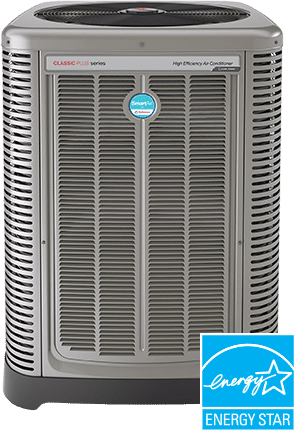
SmartAir 5000
- Delivers highest efficiency in the SmartAir line
- Delivers precise coolness and ultimate comfort in the home
- Includes programmable thermostat
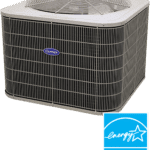
Carrier® 1000
- Affordable pricing
- Convenient programmable thermostat
- ENERGY STAR® qualified in select sizes
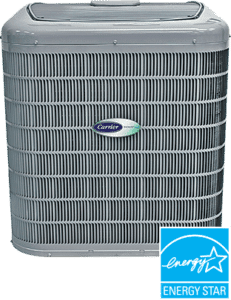
Carrier® 5000
- Low sound
- ENERGY STAR® qualified in select sizes
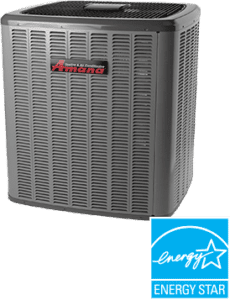
Amana® 5000
- Includes convenient programmable thermostat
- Up to 16 SEER efficiency rating
- ENERGY STAR® qualified in select sizes
- Long life, peace of mind
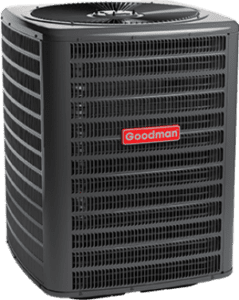
Goodman® 110
- Quiet air flow
- Environmentally friendly
- Convenient programmable thermostat
Ductless Air Conditioners
What is a Ductless Split Air Conditioner?
This type of AC system does not use ductwork to distribute cool air. Some older homes don’t have the ductwork necessary for a modern ducted AC system. This is where a ductless system is useful.
A ductless split ductless system may have multiple heads or indoor units that cool the air. These units may be mounted on a wall, floor or even ceiling. Each head cools the air in the room where it’s installed, which will allow you to set different temperatures for each unit and room.
The condensate drain, refrigerant tubing and power cable runs between the indoor heads and the outdoor unit. A small hole in the exterior wall is required to run the conduit between the indoor and outdoor units.
Portable Air Conditioners
What is a portable air conditioner (home ac unit) and how does it work?
A portable, or ‘windowless’ air conditioner can be moved from room to room, but often requires venting to remove the hot air and moisture generated by the unit. These mobile air conditioning units are placed on the floor inside a room where the heat is typically discharged through a window vent kit that comes with the unit. You may find that portable units are noisier than other types of air conditioning units since the evaporator fan is working constantly to evaporate the condensed moisture that collects within the unit .Portable AC units are also not the most aesthetically pleasing cooling option. The unit itself will take up floor space in the area you’re cooling, and it may impact the look and function of one of your windows.
How Much Space Will a Portable AC Cool?
Portable air conditioners are effective in cooling a small space. The output capacity of a portable AC can range but most retail options fall between 11,000 and 14,000 BTU, which is typically enough to cool up to 500-700 square feet. This cooling capacity makes a portable AC a good option for garages, dens, recreation and computer rooms. They can roll across floors on casters, but are limited to the length of the tubing connecting the unit to the window kit.
Advantages of Portable Air Conditioners
- Effective in spot cooling a single room.
- It’s a self-contained system which consists of only one unit.
- Easy and quick to setup (installation kit and instructions included)
- Move from room to room if desired (wheels included).
- Many are 3 in 1 units (AC, dehumidifier, fan). Select units can heat a room as well.
- Won’t cover up your window with a bulky window unit (however, the venting kit will take up some space)
- Easy to store at the end of the season
- Removes excess moisture from the air
Disadvantages of Portable Air Conditioners
Typically noisier than other AC systems
The venting kit will obstruct the lower section of a window or sliding door. It will take up some real estate on your floor
Limited cooling capacity
May impact the décor in your room (some people use DIY solutions with plywood and Styrofoam for door frame setups)
Portable AC Venting Options
Vent through a standard window
Vent through a sliding window
Vent through a sliding door (not as easy to install as window option, since a standard kit will not cover the full height of the door. You may need to combine two or more kits)
Vent through a dropped ceiling or wall
Where Does The Moisture Go?
A portable AC unit will remove both heat and moisture from the air in your room. A window kit is used to exhaust the heat outside. But where does the collected moisture go?
Manually Removed – A traditional portable air conditioner will have a container inside for collecting water. Depending on the humidity in the room you are trying to cool, you may need to empty the container once or twice daily. This could become tedious and disrupt your AC runtime.
Self-Evaporative – Higher end portable ACs will evaporate moisture and push it outside along the same exhaust hose used to push the heat from your room to the outside. This low maintenance option is usually more expensive.
Drain Hose & Pump – With some portable AC units you have an option to attach a drain hose and expel water into a drain or a desired location outside. A pump accessory may also be used to move the drained water to a desired location more effectively, especially if the hose is elevated or lengthy.
What Size Portable Air Conditioner Do I Need?
Window Air Conditioners
What is a Window Air Conditioner and How Does It Work?
The second type of smaller air conditioning unit are window ACs that fit into an open window frame in your home. These units are used to primarily cool the room in which they are installed, and condensed moisture simply drips onto the ground below outside your home. A window AC takes warm air from inside the home and cools it by running it over an evaporator coil, before blowing it back into the home. The heat absorbed by the evaporator coil is then transferred to the condenser coil where it is expelled outside.
A window air conditioner is relatively easy to install, and can be used to cool a specific room in your home if a whole house AC system is not needed. In some living spaces, like older apartments, a window AC unit is the only option.
Some window ACs have offer different cooling levels and options. Some models will cool at your desired level until you turn it off, while other more advanced models will work to maintain your preset temperature. In this case, the air conditioner will remain on until the desired temperature is met. It will continue to cycle off and on in an effort to maintain your temperature.
What Type of Air Conditioner Do I Need?
To maximize energy efficiency and lifetime of your outside air conditioning unit, keep the following recommendations in mind:
- The outdoor unit should be 12 inches away from any object
- Do not place the unit near hot areas or ones which experience frequent foot traffic
- The unit should be placed on a level pad, elevated so that the condenser will avoid contact with heavy rain accumulation and snow during the winter

If you’re experiencing problems with your current air conditioner, or if your AC is
so old and inefficient that bills keep adding up, you definitely want to look at a new system. Well,
where do you start? Well, when considering a new air conditioner, it’s important to remember that
not all air conditioners are created equal and there are different options available. There are
window units which are often used for temporary installations, in-wall units, which are typically
used in condos, and central air units, which are usually found in homes. If your home has an
existing furnace, then a central a/c unit will be your best option as they’re extremely efficient,
saving both energy and money. Now once you’ve landed on the system type, you want to consider
five key areas; the brand, output capacity, installation, rebates, and lastly, how to maximize
the life of your equipment. When purchasing a new AC you want to choose a trusted system that will
stand up to years of use, is reliable, efficient, cost-effective and if something does happen,
you need to know that the parts and service are easily available. At Reliance Home Comfort,
we work with the top brands in the industry. An air conditioner has to be sized for your home. A
Reliance Home Comfort Advisor will help you choose the best option by considering your total square
footage, sun exposure, the age of your home and its insulation, and how energy-efficient
you’re looking for the system to be. To get the most benefit out of a new system, you want to
make sure it’s installed properly so you want to hire an installation team that is well-trained,
experienced and professional. After all, you’re placing your home comfort in their hands. A
Reliance installation team will be able to ensure that your HVAC is properly installed in order to
maximize comfort, longevity and efficiency. Depending on the unit you choose and the area
that you live in, there may be government mail-in rebates and incentives available that can help
you save money. During an in-home consultation, the Reliance Home Comfort Advisor will discuss
the programs available to you. And lastly, you want to have an understanding of what your new
equipment will require in terms of regular service and maintenance to make sure you get
the maximum lifetime value from your system. Remember, if you need a new air conditioner,
Call on Reliance™ to schedule time with a Reliance Home Comfort Advisor. You can count
on our expertise to assess your home and make sure that you get the right solution for your family.
What Size Home Air Conditioner Do I Need?
A properly sized AC will provide you with the proper cooling and comfort levels throughout the summer. Whether you are looking to install a traditional split system central AC, a ductless split or heat pump, the size of unit you select is critical to ensure your living space is comfortable and energy costs are minimized.
Factors in selecting a proper air conditioning size:
- How many bedrooms are there in your home?
- What is the size of your home?
- What type of windows do you have?
- What are the insulators in your walls and your ceilings?
- Consider factors on the outside – what is the exposure of your home? (sourthern or northern) ?
Dangers of an Oversized Air Conditioner
An oversized air conditioner will cool your home but will not remove the humidity, which will make your home feel warmer and less comfortable.
Dangers of an Undersized Air Conditioner
An undersized air conditioner will not be able to keep up with demand on the hotter days which will prevent your home from maintaining your desired temperature.
Most Important Factor
When selecting an air conditioner, an engineering analysis should be performed (includes a heat loss assessment). This will provide your contractor with proper numbers that will help them recommend the right AC for your home.
Upgrade your home comfort with our special offers
Check Out Our Offers Today!
Energy Tip
Make sure to have your new air conditioner professionally sized by a licensed technician. A properly sized system will run more efficiently than an incorrectly sized unit.
Where Should I Install My New Air Conditioner?
Where Should I Install The Outside Unit of My Air Conditioner or Heat Pump?
To maximize energy efficiency and lifetime of your outside air conditioning unit, keep the following recommendations in mind:
- The outdoor unit should be 12 inches away from any object.
- Do not place the unit near hot areas or ones which experience frequent foot traffic.
- The unit should be placed on a level pad, elevated so that the condenser will avoid contact with heavy rain accumulation and snow during the winter.
Where to Install a Wall-Mounted Indoor Air Conditioning Unit?
A ductless mini-split air conditioning system may have multiple indoor air handlers. Each handler will typically reside a separate room. Here are a few guidelines around where to position the wall-mounted AC units:
- It should be at least 7 feet above your floor with at least 6 inches of space above the unit and on each side.
- At least 3 feet away from coaxial cables, electronics, Wifi modems and mobile devices to avoid the electrical noise associated with these devices.
- The integrity of the wall should be strong enough to support the unit for many years. Where possible fasten to a stud or two by four.
- Position the unit away from direct sunlight or other heat sources like an oven.
- Ensure the unit is not obstructed by anything, like a large piece of furniture.
Frequently Asked Questions (FAQs) – Around How an AC Works
A central air conditioning system will use the ‘blower’ component from the furnace to circulate air. Both the furnace and AC also share the ductwork that allows both warm and cool air to circulate as needed.
An outdoor unit can have a two-stage capacity through the compressor. A two-stage unit can run at lower capacity during humid days when full cooling is not needed and be able to extract more moisture from the air than a single stage unit that will run at full capacity for shorter periods of time. High humidity during hot summers is common in many humid climates around the world. That’s why an efficient two-stage AC work really well in those regions to create a comfortable indoor living environment.
A key component to your AC is the evaporator coil that is the part of your air conditioner that is inside your home. Refrigerant resides inside these coils, which is used to absorb heat from warm circulating air. Once the heat is removed from your home, the refrigerant returns back to the evaporator coils.
The actual steps to install a central air conditioning unit may vary depending on the exact system and contractor. But here are some common steps:
- Ductwork is installed and/or repaired as required.
- The contractor will prepare the areas where the various units will reside. A pad may be required to stabilize and secure the outside unit.
- Your contractor will connect the outside unit to the inside unit.
- Refrigerant will be added and the entire system will be thoroughly inspected and tested to ensure it is running smoothly and efficiently.
Most AC systems use either R-22 or R-410A refrigerants. All new units are R-410A. R-22 is being phased out due to its effects on the ozone layer. As a result, the price of R-22 is expected to go up significantly over the next few years, however R-22 replacements are available.R410A, also known as Puron is more environmentally friendly than R-22 (Freon). Keep in mind that R410A cannot be used in R-22 systems.
Seasonal energy efficiency ratio (SEER) is a system by which central air conditioners are rated for energy efficiency. SEER is a ratio of the cooling output and the energy used by the system. The higher the SEER value the more efficient the system. Other factors like proper installation by a qualified and experienced contractor will impact how efficient your air conditioning system ultimately performs.
How Much Does a Home Air Conditioner Cost?
A new central air conditioner can cost between $5,500 and $12,000 including installation. The cost of a new home air conditioner is influenced by its size and capacity, type, energy efficiency, brand, installation complexity, additional features, and local climate.Window air conditioners and portable ac’s range from about just over $100 to around $1300 not including installation.
| EQUIPMENT | APPROX COST | APPROX LIFESPAN* |
| Central Air Conditioner | $5,499 and up | 15 years or longer |
| Window Unit | $100 – +$1000 (not including installation) | N/A |
| Portable AC | $200-$1300 (not including installation) | N/A |
| Central Heat Pump | $6,999 and up | 15-20 years |
| Ductless Mini Split Heat Pump | $5,999 and up | 15-20 years |
Want to avoid bigger upfront costs? Consider renting or financing your air conditioning equipment with Reliance®.
1Home Depot Canada
2Home Depot Canada
*https://www.nrcan.gc.ca/energy-efficiency/energy-star-canada/about/energy-star-announcements/publications/air-conditioning-your-home/6051
*https://natural-resources.canada.ca/energy-efficiency/energy-star-canada/about/energy-star-announcements/publications/heating-and-cooling-heat-pump/6817

Ever hear the term heat pump and wondered what it means exactly?
Heat Pump technology has been around for a long time and it is commonly used in many parts of the world as a way for families to both heat and cool their homes. It can be an efficient and cost-effective way to stay comfortable, while possibly helping to reduce your carbon footprint.
What Is It? – How They Work
The best way to describe a heat pump is like an air conditioning unit that can operate in reverse. During the summer, it helps to keep you cool by removing heat from inside your home and moving it outside. It keeps your home comfortable in the cooler months by removing heat from the outside air and circulating it back indoors.
These units run on electricity, and work seamlessly with your furnace or back-up heat source so that your back-up heat source automatically takes over when the temperature becomes too cold outside for the heat pump to work effectively.
And for added convenience, heat pumps can also work with your existing ductwork and furnace fan to move air throughout your home.
Types
There are several different types of heat pumps that are available, depending on your needs, your current heating and cooling set-up, and your budget.
The most common is air source, and as the name suggests, it absorbs heat from the air and moves it either in-to or out-of your home, depending on the season.
Geothermal, or ground source heat pumps, operate like the air source units, however they use the earth or ground water to source and to expel heat. The more consistent temperatures found underground can help to make this type run more efficiently, especially during the hotter and colder days of the year.
Stand-alone units that do not require traditional ductwork are also available.
Benefits
Using a heat pump could create greater overall comfort in your home, providing consistent temperatures throughout the year.
Heat pumps move heat rather than creating it, so they can help to reduce your energy consumption and your costs, especially during milder months.
Since they run on electricity, heat pumps may produce lower CO2 emissions than a furnace that burns fossil fuels, depending on the cleanliness of your electricity supply.
And since your furnace won’t need to be running as much, you could reduce your emissions even further and help to protect yourself from fluctuating fuel costs.
Rent or Buy
Think a heat pump might be right for you?
One of our Home Comfort Advisors can help you decide which type and model might be best for your needs. There are also options to purchase your equipment or take advantage of our rental program for one low monthly fee – which includes expert installation, 24/7 live support, repairs and service.
To book your FREE in-home consultation or to speak with a Home Comfort Advisor on how we can help to reduce your carbon footprint, Call on Reliance®.
#airconditioner #airconditioning #heatpump
What is a Heat Pump?
Some of the air conditioners described above are also available in a variation of a traditional system known as a heat pump. But while an air conditioner can only move heat in one direction, out, a heat pump can be reversed and pump heat in either direction. It functions as both an air conditioner and a heater, which will allow you to heat and cool throughout the year without using your furnace until it gets really cold outside.
A heat pump runs on electricity and works seamlessly with your furnace. During the summer months, the heat pump operates like a traditional air conditioner to cool the home. During cooler months, the heat pump reverses the process to extract heat from the outside air and brings it inside the home to provide heat. Your furnace will automatically take over heating your home only once the temperature outside is too cold for the heat pump to function efficiently.
Heat pumps have been quite popular in milder climates where the temperature does not stay below freezing for extended periods. However, recent advancements in heat pump technology have made them effective even in colder climates.
In colder climates like Canada, geothermal heat pumps are popular. This type of heat pump extracts heat from the ground versus a traditional heat pump which extracts it from the air. The initial investment of a geothermal heat pump is higher than an air-sourced system. The installer for this system also requires specialized skills and experience. But the long-term energy savings can certainly be significant.
Recommended Heat Pumps
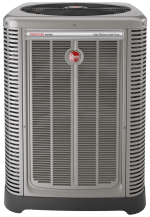
SmartAir RP20
Multi-stage heating and cooling. Pair with R96V to see how much you may qualify in rebates.
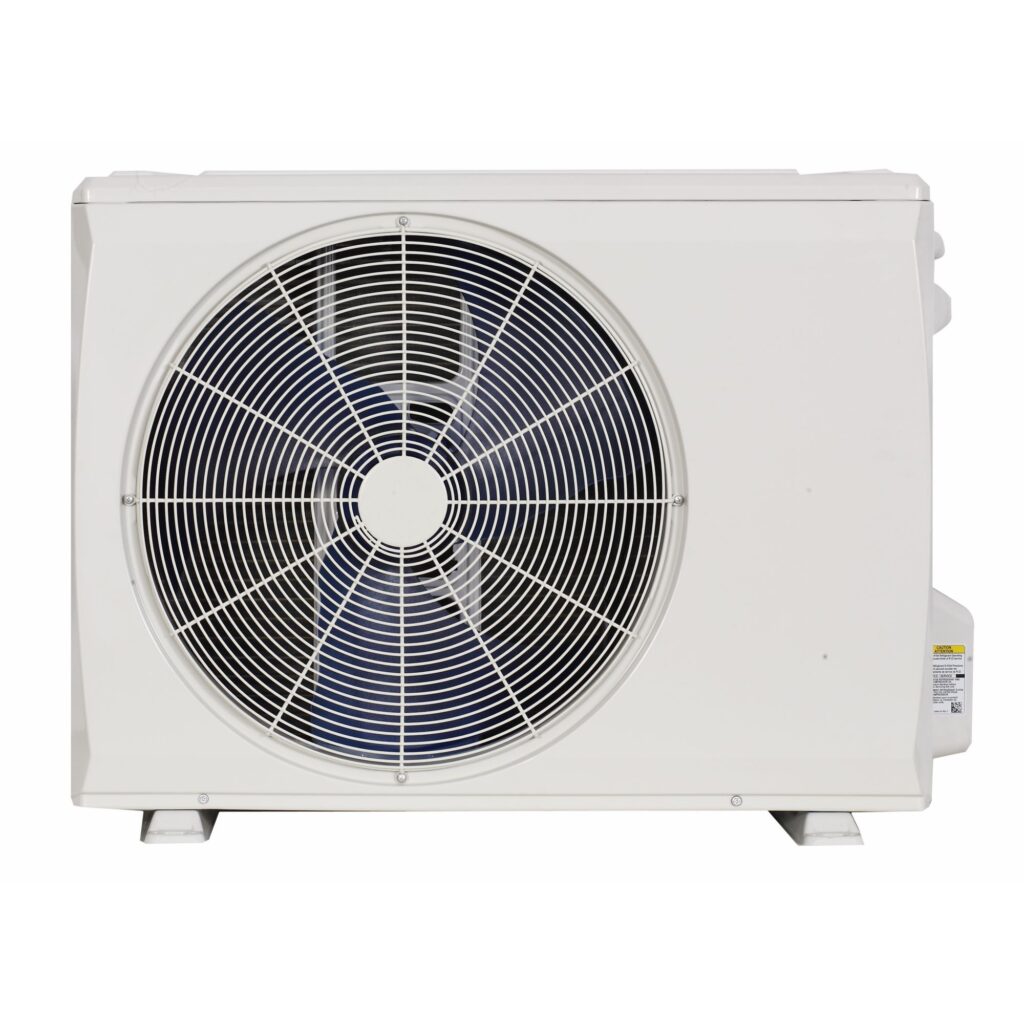
Carrier 38MARBQ
Multi-stage heating and cooling. Pair with 59TP6 to see how much you may qualify in rebates.
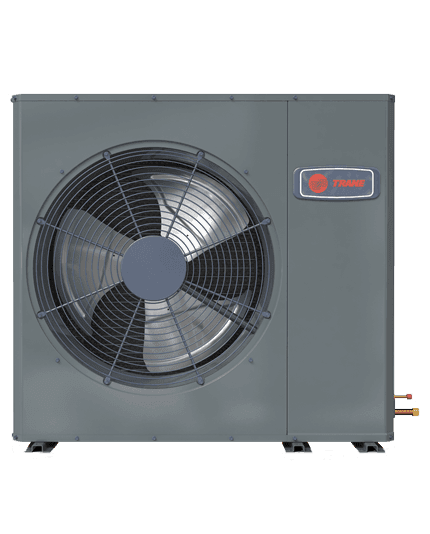
Trane: XV19
Multi-stage Pair with S9V2 or XC95m to see how much you may qualify in rebates.
Upgrade your home comfort with our special offers
Check Out Our Offers Today!
Energy Tip
All heat pumps move heat rather than create it, making them one of the most energy efficient heating and cooling systems throughout your home.
How Does a Heat Pump Work?
- Heat pumps function just like a traditional air conditioner, except the AC process can also be reversed to heat the home during the winter months.
- A central heat pump uses the same ductwork with a furnace fan to distribute warm air throughout the house.
- The compressor in the outside unit moves the refrigerant through the system.
- The heat pump also has a reversing valve that reverses the flow of refrigerant which switches the system to providing heat versus cooling.
- The heat pump also has an accumulator that allows the system to adjust the refrigerant charge automatically.
Different Types of Heat Pumps
An air sourced central heat pump is a common type of heat pump installed in many homes across North America.
Air-Sourced Central Heat Pumps: An air sourced central heat pump is a common type of heat pump installed in many homes across North America.
This type of heat pump relies on ductwork to circulate both heat and cool air in a house. Just like a central air conditioner, it contains two key units. The condenser is the outdoor unit and the indoor unit is called the evaporator coil. The refrigerant circulates between these two units. It functions just like a central AC when it absorbs heat and releases it outside. But it also works in reverse order, as it collects heat from the outside air and releases it inside the house.
Air-source heat pumps can now be used in colder climates, due to advancements in the technology. Their ability to dehumidify has also improved. This means your home will be more comfortable during those excessively humid summer days.
Ductless Split Heat Pumps: A ductless split heat pump (mini split) can be installed in homes that lack adequate ductwork. This type contains two key units. The outdoor unit, contains a condenser coil, compressor, and fan. The indoor unit is the head, which contains an evaporator coil and a fan. A ductless split system can have multiple heads to provide heat or cooling to various parts of your home.
The indoor heads can be installed on a wall, floor or ceiling. A remote control can be used to set and manage different desired temperatures in each room that contains a head. Refrigerant is circulated through tubing which connects the outdoor and indoor units.
One of the key advantages of split ductless systems is the energy savings when compared to ducted systems. One of the bigger disadvantages is the costs associated with installing a ductless split heat pump. It can get expensive to install multiple indoor units.
Aesthetically, newer models look better than older versions. But many homeowners do not like how the indoor head units look within their décor.
Geothermal Heat Pumps : A Geothermal or ground-source heat pump operates in the same manner as an air-sourced heat pump, except instead of absorbing and expelling heat into the air, it does so into the ground. They use the earth and/or ground water to source heat. The more even temperatures found in the ground, allow this kind of heat pump to operate more efficiently during the hotter and colder days of the year.
The Benefits of Heat Pumps
- A heat pump can both cool and heat your home.
- Heat pumps run on electricity and consequently may produce lower CO2 emissions than a furnace that burns natural gas. Most electricity in Canada is produced through non-carbon emitting sources, especially in British Columbia and Ontario.
- Since your furnace won’t be running as much, you could significantly reduce your home’s CO2 emissions.
- Energy savings – You can potentially reduce your energy bills due to higher efficiencies on the heat pump in milder weather.
- Flexibility – Shield yourself from increases in natural gas prices by giving yourself the choice of heating your home with either natural gas or electricity.
- Comfort – The temperature in your home could be more even and work on a more continuous basis vs. a single stage furnace.
- Performance – Quiet-running heat pumps come with an ecobee smart thermostat. The ecobee switches automatically from your heat pump to your furnace when needed
- Today’s heat pumps can heat your homes even when it’s below zero.
Money Saver Tip
Seasonal energy efficiency ratio (SEER) is a system by which central air conditioners are rated for energy efficiency. SEER is a ratio of the cooling output and the energy used by the system. The higher the SEER value the more efficient the system
Are You Looking to Buy or Rent A New Air Conditioner?
One of the most important decisions you will need to make when selecting the right AC for your home is renting versus buying. Many individuals prefer the hassle-free experience associated with renting. While others, prefer to own their air conditioning units and don’t mind all the accountability associated with ownership.

Need a new furnace air conditioner or hot water heater but not sure whether to rent or buy?
Regardless of your equipment needs, it’s important to know what’s right for you. Here’s what you need
to know to get started. A rental unit is a great option for a lot of homeowners as it gives peace
of mind. The repairs are always covered. Lifetime repairs and maintenance are included with your
rental so you’ll never be surprised with an unexpected repair bill. As a rental customer,
you’ll also have 24/7, 365 live telephone support and direct access to technicians
that know your equipment and have all the parts on hand to service it fast so
you never have to worry about being without heating, cooling or hot water. With rental,
you’ll also get the convenience of one low monthly payment that is easy to budget for.
Even with our most efficient units, there are no upfront equipment costs and you can take advantage
of any available government rebates. Plus, when you rent your heating or cooling system,
your annual maintenance is fully covered. That even includes the maintenance of your humidifier
and upgraded filters for optimal airflow. Buying is another great option. Buying your equipment
allows you to take advantage of special promotions or competitive financing rates so you can still
find the right equipment that fits your budget. Plus when you purchase your equipment, you’ll
still have access to Reliance’s large network of professionally trained technicians. We also
include standard parts and labour warranties on all of our equipment so that you will be covered
in the event of a faulty part or breakdown. You’ll also have the ability to keep your heating and
cooling equipment running efficiently by adding a Protection Plan to your purchase that includes
annual maintenance and allows you to avoid most unexpected repair costs. At the end of the day,
the best option is whatever suits the needs of you and your family. If you’re renting,
your unexpected repairs and annual maintenance for your furnace and AC are covered. With buying,
you’ll own your equipment and you’ll always have the option to cover repair and maintenance
costs with a Protection Plan after your warranty period. Whichever you choose,
you can Call on Reliance™ and schedule a time with our trusted Home Comfort Advisors. Our
Advisors will take the time to assess your needs and help you make the right decision.
Ultimately, the decision is yours. Here are some insights that will hopefully help you make the best decision for you and your family.
If you enter into an air conditioning rental agreement with a company like Reliance®, all the costs of repairs, annual maintenance and replacement of parts or entire units will be covered in your monthly fee. Since the air conditioning system is owned by the company, it will be in their best interest to ensure its working well and in great condition, as their long-term success and reputation is measured by great customer service.
If you choose to rent, ensure the company you are renting from is active in scheduling annual maintenance and tune-ups, is quick to replace broken equipment and is available 24/7. You should also consider how long the company you are considering has been in operation, the level of service it provides and how many customers it services on a monthly or annual basis.
Be sure to visit our Air Conditioning Offers page to take advantage of any deals and discounts.
You may also be eligible for mail-in rebates. Find rebates in your area by visiting our Rebates page.
Why Should I Rent?
Don’t want to worry about upfront costs, ongoing maintenance or expensive repairs? Renting an air conditioner could be the answer. Here’s what you need to know:
Rent and Relax
Year-round peace of mind
Standard installation included
Manufacturer recommended annual maintenance included
Repairs at no cost*
One low monthly rental payment
Option to buy out anytime
Finance
Flexible payment and financing options to fit your budget
Find out quickly if you are approved
One low monthly payment
Take advantage of any of our current deferral offers
Competitive interest rates
Buy
Full upfront payment required but you will own it
Option to take advantage of any qualifying rebates or incentives
Protection plans available for maintenance and repairs
Upgrade your home comfort with our special offers
Check Out Our Offers Today!
Choosing and Replacing Filters
Air filters play an important role in your heating and cooling system. By preventing dirt and dust from entering your equipment, air filters help to ensure that your system isn’t putting in overtime to keep your home comfortable. These filters also help to remove pollutants from the air, maintain good air quality in your home, and make sure the air you and your family are breathing is cleaner.
To keep your system running smoothly and your air quality optimal, it’s important to make sure your filters are regularly maintained and replaced.
Choosing the right AC air filter
Depending on your home and the needs of your family, there are various air filters available to suit your needs. When selecting the right air filter for your home, you want to take into account the filter’s minimum efficiency reporting value (MERV) rating. The MERV rating give filters a score from between 1-20 that indicates the air filter’s ability to capture airborne particles while air is flowing through your cooling system. The higher the MERV rating, the smaller the particles the filter will capture before the air is circulated into your home. When you’re selecting a new air filter, it is recommended that your filter have a MERV rating of at least a 7.Beyond the ratings, there are several different types of air filters to consider when you are making your decision. The needs of your family, the number of pets in your home, and your budget can impact which is the right air filter for you. Below is a list of some of the most common types of residential air filters that you can choose from:
Fiberglass air filters – These filters are an economical option but only capture up to 20% of pollutants ranging from 3 to 10 microns and may not be as effective in improving your indoor air quality and should be replaced more often.
Electrostatic air filters – These filters contain self-charging paper fibers, which help to reduce the airborne irritants and allergensin your home’s air by attracting and trapping small particles.
Pleated air filters – Coming in at only a slightly higher cost than Fiberglass and Electrostatic air filter, pleated air filters are another great option. Made from polyester or cotton paper, these disposable filters capture between 70-90% of the dust and pollutants in your home from 3 to 10 microns in sizeand need to be replaced less often than Fiberglass filters.
High-efficiency air filters – These filters are generally considered to be the most effective filters for a residential heating and cooling system. These filters can trap up to 95% of particles between 3 and 10 microns in size, including pollen, tiny dust particles and mold to help improve your home’s air quality.
What Are The Best AC Filters for Allergies?
If you or someone in your home frequently suffers from seasonal or airborne allergens, selecting the right air filter may help. When choosing your air filter, ensure that the filter has a MERV rating of at least a 7-12. A pleated or high-efficiency air filter will generally trap a higher percentage of particles and pollutants before the air is circulated throughout your home. You may also want to consider replacing your filters more frequently, at least once a month.
How to Replace My Air Conditioner Filter?
If you or someone in your home frequently suffers from seasonal or airborne allergens, selecting the right air filter may help. When choosing your air filter, ensure that the filter has a MERV rating of at least a 7-12. A pleated or high-efficiency air filter will generally trap a higher percentage of particles and pollutants before the air is circulated throughout your home. You may also want to consider replacing your filters more frequently, at least once a month.
- First you need to locate your old filter – In some cases the filter housing may live behind a main vent. In other cases you may find it behind your furnace. Don’t forget to turn off your unit before you remove the filter.
- Figure out what size and type you need – your old filter should have the size printed on the side of it. Match this with the size of your replacement filter. There are many different filter types. When selecting the right one for your home consider how long each type will last and what type of air filtration you and your family require.
- Install your new filter – insert your brand new filter into the filter housing and fasten the cover or snap it back into place. Ensure you insert the new filter is in the right direction. There should be an arrow pointing which way it needs to be inserted.

Like most people, you probably don’t give your furnace much thought as long as it’s
keeping you warm during the cold winter months.
But in order to keep your furnace running at peak efficiency, you’ll have to maintain
it and change the filter on a regular basis.
Furnace filters protect your furnace from dust, hair and other debris that gets drawn
in through the cold air return ducts.
If dirt gets into the furnace, it can increase fuel consumption and maintenance costs while
also reducing furnace life.
Furnace filters also remove dust and allergens from your home which can contribute to improved
air quality for you and your family.
If a filter looks dirty as you pull it out, it needs to be replaced or cleaned.
There are many types and sizes of filters.
Most have something called the MERV rating.
This is a number from 1 to 20 that identifies the effectiveness of the filter.
The higher the MERV rating, the better the filter is at capturing small particles.
A MERV rating between 7 and 13 is ideal for most homes.
Make sure the filter you choose isn’t too restrictive as this can cause your furnace
to work harder which could lead to increased energy usage and shorter equipment life.
The most common furnace filter has disposable pleated paper as the filtration element.
Pleated paper does a good job of removing most household particles and allergens with
a MERV rating of between 6 and 13.
Disposable fibreglass filters are an inexpensive option, but tend to have a lower MERV rating.
Inspect your furnace filter every 30 to 60 days.
The frequency of filter maintenance depends on a number of factors; the type of filter
you’re using, how many people live in the home, the amount of dust and if you have pets,
all affect the filter’s lifespan.
Changing a furnace filter is simple.
First, make sure your furnace is turned off so it doesn’t blow air when you remove the
filter.
Next, locate the filter housing on your furnace.
This is different for each model but you can normally find it between the air intake and
the furnace.
Open the compartment door and slide the filter out.
Compare the size and type of replacement filter with the old one.
Specifications should be printed on the side of the filter.
If size information isn’t printed on the filter frame, measure the filter yourself, rounding
up to the nearest half inch.
Slide the newer, clean filter in place with the arrows pointing towards the furnace in
the direction of air flow.
Secure the compartment cover, then turn your furnace back on.
Now all that’s left to do is set a reminder for your next inspection.
If you need assistance with any furnace maintenance or repair, Call on Reliance.
How to Clean My Air Conditioner Filter?
If you use a reusable air filter, it’s important that the filter is cleaned and maintained every 1-3 months to ensure unrestricted airflow and decrease the amount of particles in your air. To clean your reusable air filter, you can use a vacuum to remove the loose debris and then wash with warm water to clean the remaining dust and dirt. If it’s been a while since you last cleaned your filter or if there is a significant amount of build-up on the filter, you may want to consider cleaning it using a mild detergent with warm water. Once you’ve cleaned your filter, be sure to let it dry completely before reinstalling it in your heating and cooling system.
How often should I change my air filter?
The frequency in which you should be changing your air filter depends on a few factors in your home. The number of people living in the house, the number of pets you have, and if anyone in your home suffers from allergies, impacts how often you should be changing your indoor air filters. As a general rule, it’s recommended that you change your filter every 30-60 days for optimal air quality. If you have several pets in your home, or regularly suffer from severe allergies, you may want to consider replacing your air filters more often.
How to Maintain a Central Air Conditioning System?

We all know the good things last when you take care of them and really it’s no different for
your air conditioning system. When you consider the amount of work your furnace
and AC do hour by hour, day by day year, after year, you could save yourself the headaches,
time and money that comes with repairs and ensure your house is cooled on those hot summer days
simply by having your air conditioning system checked and maintained annually.
What people may not realize, is that all AC systems require regular maintenance and
tune-ups to run efficiently and a system that goes without service not only could it result
in premature wear and tear on key components, but it could also experience additional stress
that reduces its life and efficiency. So regardless of the age of your air conditioner,
plan for seasonal maintenance with a professional early in the spring before those hot summer days
hit. At Reliance, our friendly, expert technicians are always available to make
sure your system is running efficiently. We’ll be there when you need us and are always mindful
of your time and your home. Call on us to have your system expertly serviced or sign
up for one of our Maintenance and Protection Plans to make sure you’re always covered.
How to Choose an Air Conditioning Maintenance Company?
Here are a few things to keep in mind when choosing an air conditioning contractor or company to maintain your AC system and perform annual tune-ups:
- Find out how many service calls the company does each year
- How prompt are the technicians? Avoid companies that take days to respond to a service request. They are often over capacity and rush through service calls which may impact the quality of their work
- How well are the technicians trained and does the company have a good variety of expert technicians who specialize in different HVAC solutions?
- Take some time to read their reviews online to determine if a dedication to exceptional customer service is a top priority for the company
Safety Tip
When you’re maintaining your AC and getting your home ready for summer, make sure to test both your fire alarm and carbon monoxide detector as well as change the batteries. Be sure to do this at least twice a year.
How to Clean Air Conditioning Ducts and Vents?
We recommend hiring a professional and reputable duct cleaning company to thoroughly clean the ducts and vents in your home. Those on a tighter budget, may want to consider a DIY option
How Do I Know if My Air Conditioner Ducts Need to Be Cleaned?
Here are a few questions you should ask yourself to determine whether it’s time to get your air ducts cleaned:
- Have you recently completed renovations
- Can you remember the last time you ducts were cleaned
Tech Tip
Do not try to open or repair a furnace. Unless you are a qualified furnace technician, never attempt to remove the door or open the furnace in any way. Electronics and anything inside your furnace are for professionals only
Most Common Central Air Conditioner Issues and What You Should Do
There are many reasons why your air conditioning system may not be working. Here are some of the most common ones:
- Faulty contactor
- Faulty start/run capacitor
- Compressor fan motor has stopped
- Blower motor is not working
- Refrigerant leak in the coils
To avoid these common issues, we highly recommend getting an annual inspect and tune-up. Waiting until something breaks could cost you a lot more money in the long-term.
There could be many reasons why your air conditioner is not cooling. Here are a few that may help you troubleshoot the issue.
- It’s time to replace your dirty AC filter which may be significantly reducing the air flow into your air conditioner.
- Improper thermostat settings are not turning on your AC as needed.
- Check to see the condition of your outside unit. You outside AC unit may be dirty and covered with debris. Make sure this unit is not obstructed by anything.
- The compressor inside your outside unit may be broken. A professional HVAC technician will be able to determine if this is the case.
- Your AC unit does not have enough refrigerant due to a leak. Once again, a qualified air conditioning technician will be able to confirm if this is the case.
- If the condenser fan is no longer running inside your outside AC unit, call a technician right away.
- Read our article on How to Solve Uneven Home-Cooling Issues for even more tips.
Your thermostat was not installed properly or programmed to cool the warm air in your home
The electrical breaker for your AC has turned off
Your filter is clogged or dirty
If the above is not the problem, then you most likely have a broken component somewhere in your system
A leaking air conditioner coil can be repaired, although it is normally easier and more cost effective to simply replace the evaporate.
Freezing up is a pretty common issue across air conditioner types. It’s important to address this issue immediately, otherwise, you will risk permanently damaging your AC system, which can be very costly. A few reasons why your AC may be freezing up:
- A mechanical failure like a malfunctioned blower fan.
- If the temperature outside is too low.
- Your AC does not have enough refrigerant.
- Poor air flow across the evaporator coils.
Tech Tip
As a general rule, it’s recommended that you change your filter every 30-60 days for optimal air quality. If you have several pets in your home, or regularly suffer from severe allergies, you may want to consider replacing your air filters more often.
AC Energy Savings Tips
Even when the temperature is rising, you want to make sure that your energy bill stays low. When you are looking at a new AC unit and how to best keep it running throughout the season, there are a few things you can do to help save on energy.
- Consider an ENERGY STAR® certified Air Conditioner* When selecting a new air conditioner for your home, look to see if the unit is
ENERGY STAR® certified. AC models with this certification have a higher seasonal energy ratio (SEER) and energy efficiency ratio (EER) that will help to reduce your energy consumption throughout the summer months. - Upgrade your home’s thermostat Upgrading your thermostat from a manual to a programmable or smart thermostat can help you have more control over both your home’s temperature and energy bill.
- Use ceiling fans Ceiling fans can help to keep your home comfortable and take some of the pressure off of your AC by keeping the cooled air circulating throughout your home. During the summer, make sure that your fan is set to spin counter-clockwise for maximum cool air distribution.
- Close your curtains and blinds Depending on the direction of your home, a window that allows in direct sun exposure can heat up your home in no time. Limit the sunlight coming in by closing the blinds and curtains on your windows.
- Increase shade around your home If you’ve got space around the perimeter of your home, consider planting trees and tall shrubs to give your home more shade. By decreasing the direct sunlight your home gets, you can help to reduce your cooling needs.
- Learn even more ways to save on AC cooling costs
Energy Tip
Upgrading both your furnace and your air conditioner to efficient models at the same time will help you maximize your energy savings.
If you have any questions about cooling your home or are looking for a new air conditioner, Call on Reliance today to schedule time with one of our trusted Home Comfort Advisors. The advisor will assess your home and discuss your needs to find the right solution for you and your family.
Looking for more information on Home Air Conditioner Systems? Visit our Air Conditioner Resources page.
More AC Resources
*The ENERGY STAR® name and symbol are administered and promoted in Canada by Natural Resources Canada and are registered in Canada by the United States Environmental Protection Agency.


